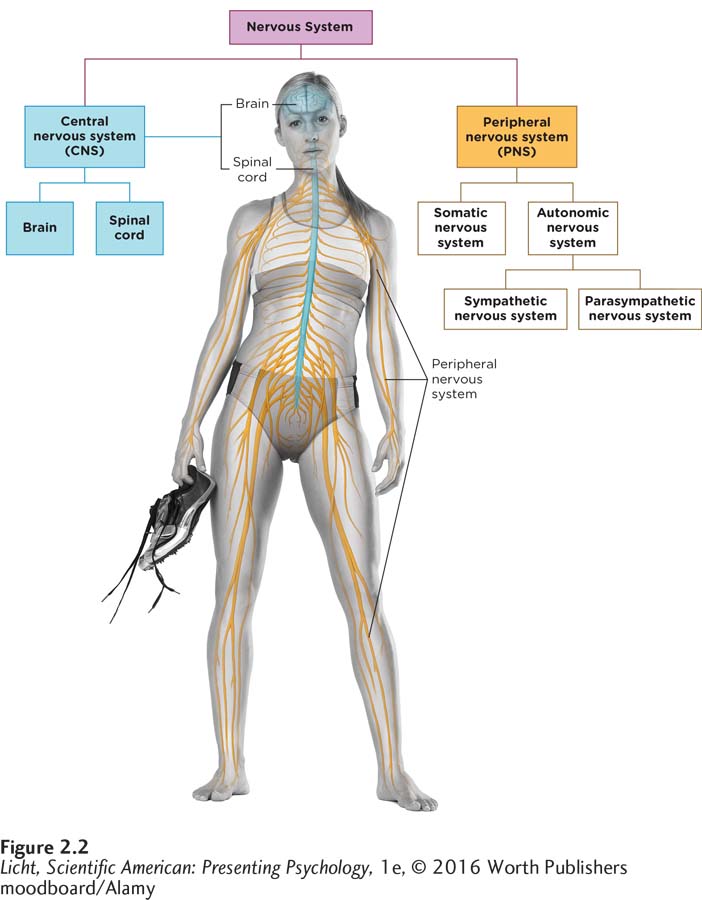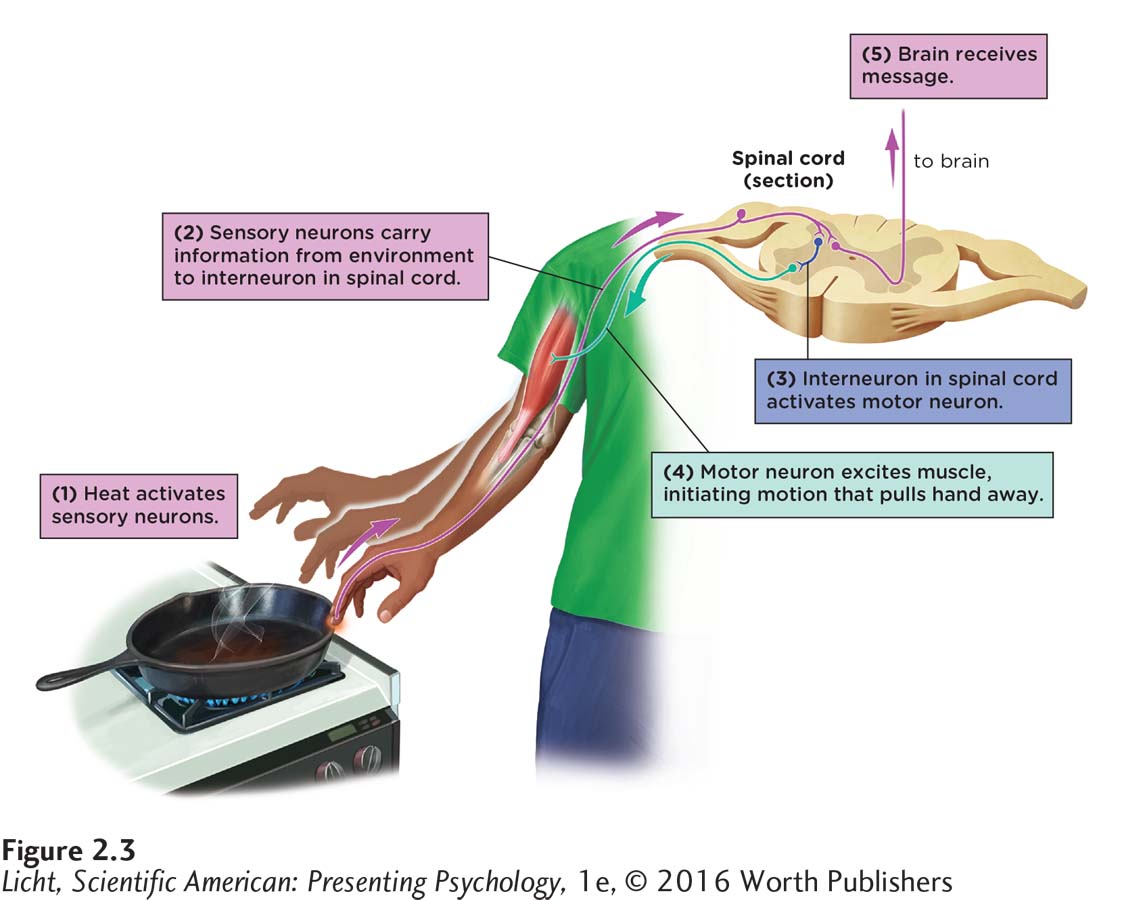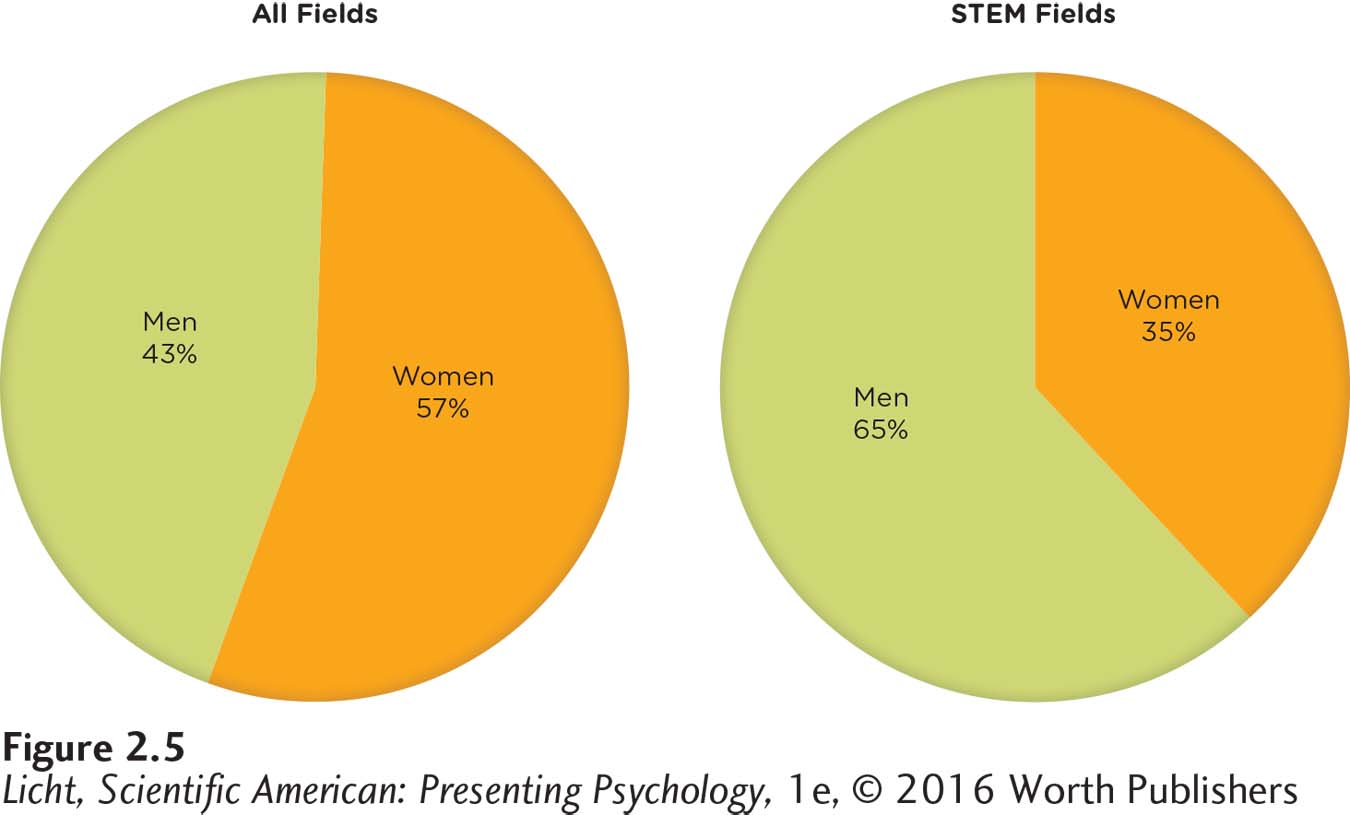2.3 The Supporting Systems
central nervous system (CNS) A major component of the human nervous system that includes the brain and spinal cord.
peripheral nervous system (PNS) The part of the nervous system that connects the central nervous system to the rest of the body.
Like any complex system, the brain needs a supporting infrastructure to carry out its directives and relay essential information from the outside world. Running up and down your spine and branching throughout your body are neurons that provide connections between your brain and the rest of you. The central nervous system (CNS) is made up of the brain and spinal cord. The peripheral nervous system (PNS) includes all the neurons that are not in the central nervous system and is divided into two branches: the somatic nervous system and the autonomic nervous system. The peripheral nervous system provides the communication pathway between the central nervous system and the rest of the body. Figure 2.2 gives an overview of the entire nervous system.

The nervous system is made up of the central nervous system, which includes the brain and spinal cord, and the peripheral nervous system.
The Spinal Cord and Simple Reflexes
spinal cord The bundle of neurons that allows communication between the brain and the peripheral nervous system, connecting with the body’s muscles, glands, and organs.
Brandon suffered a devastating brain injury that temporarily immobilized half of his body. The paralysis could have affected his entire body if the bullet had pierced his spinal cord. This bundle of neurons allows communication between the brain and the peripheral nervous system, which connects with the body’s muscles, glands, and organs. The spinal cord has two major responsibilities: (1) receiving information from the body and sending it to the brain; and (2) taking information from the brain and sending it throughout the body. If this pathway is blocked, commands from the brain cannot reach the muscles responsible for making you walk, dance, and wash dishes. Likewise, the skin and other parts of the body have no pathway for communicating sensory information to the brain, like “Ooh, that burner is hot,” or “Oh, this massage feels good.”
LO 6 Explain how the central and peripheral nervous systems connect.
sensory neurons Neurons specialized for receiving information about the environment from the sensory systems and transmitting this information to the brain for further processing.
motor neurons Neurons specialized for transmitting information from the central nervous system to other parts of the body, such as muscles and glands.
interneurons Neurons that reside exclusively in the brain and spinal cord; act as a bridge connecting sensory and motor neurons.
Synonyms
sensory neurons afferent neurons
motor neurons efferent neurons
interneurons association neurons, relay neurons
How do the brain and spinal cord, which make up the central nervous system, communicate with the rest of the body through the peripheral nervous system? In essence, there are three types of neurons participating in this back-
reflex arc An automatic response to a sensory stimulus, such as the “knee-
THE REFLEX ARC Some activities don’t involve the interneurons in the brain (at least at the start). Consider the withdrawal reaction to painful stimuli (Figure 2.3 below). If you accidentally touch a hot pan, you activate a pathway of communication that goes from your sensory neurons through interneurons in your spinal cord and right back out through motor neurons, without initially involving the brain. This type of pain reflex includes a number of steps: (1) Your hand touches the hot pan, activating sensory receptors, which cause the sensory neurons to carry a signal from your hand to the spinal cord. (2) In the spinal cord, the signal from the sensory neurons is received by interneurons. (3) The interneurons quickly activate motor neurons and instruct them to respond. (4) The motor neurons then instruct your muscles to contract, causing your hand to withdraw quickly. A sensory neuron has a rendezvous with an interneuron, which then commands a motor neuron in the spinal cord to react—

Without any input from the brain, the spinal cord neurons are capable of creating some simple reflexive behavior. While this reflex is occurring, sensory neurons also send messages to the brain, letting it know what has happened.
Eventually, your brain does process the event; otherwise, you would have no clue it ever happened. You become consciously aware of your reaction after it has occurred (My hand just pulled back; that pan was hot! ). Although many sensory and motor neurons are involved in this reaction, it happens very quickly, hopefully in time to reduce injury in cases when the reflex arc involves pain. Think about touching a flame or something sharp. You want to be able to respond, without waiting for information to get to the brain or for the brain to send a message to the motor neurons instructing the muscles to react.
Test your knowledge of the reflex arc using Brandon as an example. As you recall, Brandon’s brain injury led to paralysis on the right side of his body. What do you think would happen if a doctor tapped on his right knee—
try this
What Lies Beyond: The Peripheral Nervous System
LO 7 Describe the organization and function of the peripheral nervous system.
nerves Bundles of neurons that carry information to and from the central nervous system; provide communication between the central nervous system and the muscles, glands, and sensory receptors.
The peripheral nervous system (PNS) includes all the neurons that are not in the central nervous system. These neurons are bundled together in collections called nerves, which act like electrical cables carrying signals from place to place. Nerves are the primary mechanism for communication by the peripheral nervous system, informing the central nervous system about the body’s environment—
somatic nervous system The branch of the peripheral nervous system that includes sensory nerves and motor nerves; gathers information from sensory receptors and controls the skeletal muscles responsible for voluntary movement.
THE SOMATIC NERVOUS SYSTEM The somatic nervous system includes sensory nerves and motor nerves. (Somatic means “related to the body.”) The sensory nerves gather information from sensory receptors and send it to the central nervous system. The motor nerves receive information from the central nervous system and send this information to the muscles, instructing them to initiate voluntary muscle activity (which results in movement). The somatic nervous system controls the skeletal muscles that give rise to voluntary movements, like using your arms and legs. It also receives sensory information from the skin and other tissues, providing the brain with constant feedback about temperature, pressure, pain, and other stimuli.
autonomic nervous system (ȯ-tə-ˈnä-mik) The branch of the peripheral nervous system that controls involuntary processes within the body, such as contractions in the digestive tract and activity of glands.
THE AUTONOMIC NERVOUS SYSTEM Meanwhile, the autonomic nervous system (ȯ-tə-ˈnä-mik) is working behind the scenes, regulating involuntary activity, such as the pumping of the heart, the expansion and contraction of blood vessels, and digestion. Most of the activities supervised by the somatic nervous system are voluntary (within your conscious control and awareness), whereas processes directed by the autonomic nervous system tend to be involuntary (automatic) and outside of your awareness. Just remember: Autonomic controls the automatic. But this is not a hard-
sympathetic nervous system The division of the autonomic nervous system that mobilizes the “fight-
The autonomic nervous system has two divisions involved in our physiological responses to stressful or crisis situations (Figure 2.4 below). The sympathetic nervous system initiates what is often referred to as the “fight-

The autonomic nervous system has two divisions, the sympathetic and parasympathetic nervous systems. In a stressful situation, the sympathetic nervous system initiates the “fight-
parasympathetic nervous system The division of the autonomic nervous system that orchestrates the “rest-
The parasympathetic nervous system, on the other hand, oversees the “rest-
The fight-
TEND AND BEFRIEND Fighting and running like mad are not the only ways we respond to stress. Many women have an inclination to “tend and befriend” in response to a threat—
Women are generally more likely to “tend and befriend,” but are there other gender disparities related to the nervous system? Some people believe males and females are “hardwired” differently; others believe they are socially conditioned to develop certain skills and tendencies. Let’s take a look at some of the evidence.
THINK again
Male Brain, Female Brain
 It is a well-
It is a well-
SCIENCE AND THE SEXES

Women earn the majority (57.3%) of all bachelor’s degrees awarded in the United States. But when it comes to degrees awarded in science, math, and engineering, the numbers look very different (National Science Foundation, 2015). Why do so many fewer women receive degrees in STEM fields?
CONNECTIONS
In Chapter 1, we presented the nature–
But there might also be something biological at play. Research shows that male and female brains are far more alike than they are different, but some intriguing disparities exist, both in terms of anatomy and function. For example, the cerebral hemispheres are not completely symmetric, and males and females differ somewhat in these asymmetries (Tian, Wang, Yan, & He, 2011). One fMRI study found that certain regions of the limbic cortex and the frontal lobes were larger in women, while areas of the parietal cortex, the amygdala, and hypothalamus were larger in men (Goldstein et al., 2001; the lobes and other regions of the brain are discussed in the second half of this chapter). MRI analyses point to sex differences in the brain networks involved in social cognition and visual-
It appears that both nature and nurture are responsible for the gender imbalance in math and the sciences. While women are statistically underrepresented in these fields, their participation has grown dramatically over the past 50 years, a clear sign of positive change. Researchers propose that “Having more women in STEM careers would decrease the gender wage gap in society, as STEM jobs for women pay about 33% more, on average, than non-
The Endocrine System and Its Slowpoke Messengers
Imagine that you are 19-
When faced with imminent danger, the sympathetic nervous system responds almost instantaneously. Activity in the brain triggers the release of neurotransmitters that cause increases in heart rate, breathing rate, and metabolism—
LO 8 Summarize the role of the endocrine system and how it influences behavior.
endocrine system (en-
hormones Chemical messengers released into the bloodstream that influence mood, cognition, appetite, and many other processes and behaviors.

This system of glands communicates within the body by secreting hormones directly into the bloodstream.
The endocrine system (en-
When neurotransmitters are released into a synaptic gap, their effects can be almost instantaneous. Hormones usually make long voyages to far-
pituitary gland The pea-
If the endocrine system had a chief executive officer, it would be the pituitary gland, a gland about the size of a pencil eraser located in the center of the brain, just under the hypothalamus (a structure of the brain we will explore later). Controlled by the hypothalamus, the pituitary gland influences all the other glands, as well as promoting growth through the secretion of hormones.
thyroid gland Gland of the endocrine system that regulates the rate of metabolism by secreting thyroxin.
adrenal glands (ə-drē-nəl) Part of the endocrine system involved in responses to stress as well as the regulation of salt balance.
The thyroid gland regulates the rate of metabolism by secreting thyroxin, and the adrenal glands (ə-drē-nəl) are involved in responses to stress and regulation of salt balance. Other endocrine glands and organs directed by the pituitary include the pineal gland, which secretes melatonin (controls sleep–
Now that we have discovered how information moves through the body via electrical and chemical signals, let’s turn our attention toward the part of the nervous system that integrates this activity, creating a unified and meaningful experience. Let’s explore the brain.
show what you know
Question 1
1. ____________ carry information from the central nervous system to activate various parts of the body, such as muscles and glands.
Interneurons
Dendrites
Sensory neurons
Motor neurons
d. Motor neurons
Question 2
2. When a stimulus causes an involuntary response, we refer to it as a reflex arc; the simple communication pathway goes from a sensory neurons through interneurons in the ____________ and back out through motor neurons.
brain
spinal cord
axon hillock
nodes of Ranvier
b. spinal cord
Question 3
3. The ____________ gland, located in the center of the brain, just under the hypothalamus, is in charge of the endocrine system.
pituitary
Question 4
4. When confronted with a potentially threatening situation, the sympathetic nervous system sometimes prepares for “fight or flight” and/or “tend and befriend.” How would you explain these two very different responses using the evolutionary perspective?
Both types of responses tend to increase the likelihood of survival and reproduction. The fight-